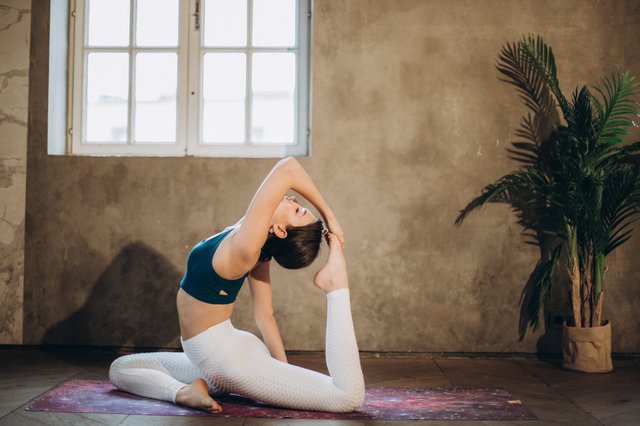The One-Legged King Pigeon Pose of Yoga Opens the Shoulders & Chest
The One-Legged King Pigeon Pose also has an acrobatic angle to it, although this not all that difficult to do. The learning curve though is longer as it involves bending, balancing and stretching all in one pose. Due to this combination it also has multiple benefits. The Eka Pada Rajakapotasana pose opens the shoulders and chest and so is good for those who suffer from asthma. In this pose, your body looks like a pigeon, hence the name for this pose.
How to Do the One-Legged King Pigeon Pose
Although the pose is named after a bird, your first posture mimics that of a four legged animal. You need to be on all fours. Your legs are bent at your knees, which are straight below your hip, while your thighs are vertical. From your knees downwards your legs are aligned along the mat. Your hands are placed in front.
You can start with either leg. Suppose you start with the right leg, you may bring your right knee forward near your right wrist and bend your leg at the knee. The shin of your right leg is under your hip. Straighten your left leg and stretch it as far back as you can.
Now move your left hand behind your back and touch your straightened left leg. In the final stage, your hand needs to go above your shoulder and hold the leg, but to begin with you may take the hand behind you in the manner most comfortable to you. If your back is supple, you may be able to touch the heel of your left foot. Firmly hold the ankle of your left foot with your left hand and pull your left leg up as much as you can. You may not be able to raise it substantially, but while learning, that is fine.
Now reach your right hand too up to the heel of your left leg that is held aloft. If you can reach the heel with your right hand too, that is commendable. But do not worry if you cannot touch the heel at your first attempt. Keep trying and you will succeed.
After you are able to grasp the ankle of your left leg with both your palms, then try to move the leg further up until you can bring the sole to touch the back of your head.
This is not at all easy to do and learners may require a partner to support your upraised leg. It is not uncommon to tie a rope to your upraised leg and pull the rope instead of the leg.
While you are still learning, do this exercise with a wall behind you. A low stool or a low window sill will also help as you can place your left leg on it before you can lift it further and touch the back of your head.
Some students of yoga take weeks and even months of practice before they can do this step. The point here is to raise your foot. So even if you are never able to touch the back of your head with your foot, that’s fine as long as you raise your foot to the extent permitted by your body’s suppleness. Until you are comfortable, you may have a partner to help you balance when you lift your leg. After you bring the leg to the highest possible level, pause and breathe normally.
How to Come Out of the One-Legged King Pigeon Pose
Ask your partner to hold your upraised leg and help you to lower it and set it down on the floor. Next you may spread your hands and rest them on some support to help you to balance yourself. After your upraised leg rests on the floor, bring it forward to align it with the right leg that has been on the mat all through this exercise. After you learn to master this exercise you will be able to gradually bring down the upraised leg without any help.
Benefits of the One-Legged King Pigeon Pose
The One-Legged King Pigeon Pose builds your body’s resistance against asthma as it opens the shoulders and chest. It also stretches your thighs, groin, chest, and abdomen and stimulates the abdominal organs to secrete better.
To derive comprehensive benefits from the different yoga exercises, do this exercise along with other yoga exercises like the Ardha Chandrasana to resist ailments like osteoporosis and slipped disc, the Mandukasana to resist diabetes, and the Halasana to exercise your entire body with a single posture
Cautions
Those suffering from any back or hip ailment, ankle or knee injury or chronic stiffness in the hips or thighs should not do this exercise. In any case do consult your doctor and yoga therapist before you start doing this exercise.
Eat Food with High Nutrient Value
Insist on food with high nutrient value. Eat non-greasy, high fiber and low calorie food. This can to supplement your yoga exercises and help you to get the best out of them.
